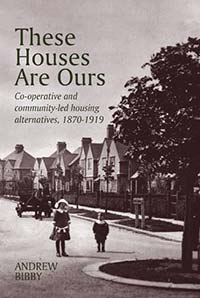Monday, 2 October 2023
Hebden Bridge Local History Society Report
The early co-operative housing movement and Hebden Bridge's part in it
Speaker: Andrew Bibby
'A brighter, happier, more joyous life': the vision of what co-operative housing could offer to working people at the turn of the 19th century.
 Andrew Bibby is a writer and journalist well known to the Hebden Bridge Local History Society for his particular interest in the British co-operative movement, and the special role played by Hebden Bridge in this history. His recent research has focused on housing co-operatives.
Andrew Bibby is a writer and journalist well known to the Hebden Bridge Local History Society for his particular interest in the British co-operative movement, and the special role played by Hebden Bridge in this history. His recent research has focused on housing co-operatives.
After the founding of the Rochdale Pioneers at Toad Lane in 1844, a wave of co-operative societies and institutions spread, creating 'a valley of co-operation'. There were soon retail co-ops in Todmorden and Hebden Bridge and by the 1860s most hillside villages had their own co-op. There was also the nationally famous Nutclough Fustian Workers' co-operative.
By the end of the century co-operation was a powerful national movement, and had extended into wholesale, banking, insurance and flour making. But despite the provision of homes being one of the its original aims, there was as yet no real co-operative housing movement.
Some local street names provide evidence of small scale investment in housing in this area, with names such as Industrial Street, Co-operative Street, and Co-operative Terrace.
By 1903 about £8 million was invested in 37,200 houses, but this was mostly in mortgages, not co-ownership, and the houses were the conventional close packed terraces deemed suitable for the working classes. There was no grand vision. Elsewhere, the garden city movement proposed building homes not in serried streets, but on green-field sites, with open spaces and room for leisure.
These principles were a good match for co-operation and the aims of a newly formed Labour Association launched in Hebden Bridge. Nutclough was its northern centre and Crossley Greenwood (son of Joseph, founder of Nutclough) became a leading proponent of its ideas. This Co-operative Tenants' Society model was based on shared investment and shared ownership and a central aim was to provide communal spaces – meeting rooms, sports facilities and room for a social life.
Seeing beyond the provision of basic houses to a vision of community living was the work of George Lister Sutcliffe, a Hebden Bridge architect (designer of Birchcliffe Chapel). After a move to London he became the in-house architect for the Co-operative Tenants' Society. The movement was widespread before 1914, with dreams of a brighter more joyful life becoming reality across the country.
Hebden Bridge came close to having such a village built at Eaves Bottom – 'a site fitted to become an arcadia and to ring with song and happiness', but a fall in trade made this uneconomic. And when the first world war ended, the urgency of housing need dictated a different route of mass municipal housing, and many of the co-operative partnerships were broken up.
Ten co-operative estates survive, including two in Manchester at Fairfield and Burnage, still boasting the gardens, playgrounds, meeting halls and bowling greens of the original vision. The houses are owned collectively, as the title of Andrew's latest book on this fascinating history claims 'These houses are ours.'
On 11th October Sheila Graham will be looking 'Inside the Mind of Oliver Heywood' – 17th century preacher and diarist. All welcome.
Hebden Bridge Local History Society meets on the second and fourth Wednesday of the month at Hebden Royd Methodist Church, starting at 7.30 pm. Details of the History Society talks programme, publications and of archive opening times are available on the History website and you can also follow the History Society Facebook page.
With thanks to Sheila Graham for this report
See also: the HebWeb History section

